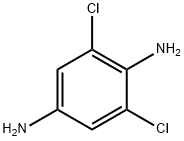CHEMICAL AND PHYSICAL PROPERTIES
| Physical Description | 2,6-dichloro-p-phenylenediamine appears as gray, microcrystalline powder or solid. (NTP, 1992) |
|---|---|
| Melting Point | 255 to 259 °F (NTP, 1992) |
| Solubility | less than 1 mg/mL at 75 °F (NTP, 1992) |
| Chemical Classes | Nitrogen Compounds -> Amines, Aromatic |
SAFETY INFORMATION
| Signal word | Danger |
|---|---|
| Pictogram(s) |
 Exclamation Mark Irritant GHS07  Health Hazard GHS08 |
| GHS Hazard Statements |
H302:Acute toxicity,oral H319:Serious eye damage/eye irritation H334:Sensitisation, respiratory H351:Carcinogenicity |
| Precautionary Statement Codes |
P260:Do not breathe dust/fume/gas/mist/vapours/spray. P280:Wear protective gloves/protective clothing/eye protection/face protection. P312:Call a POISON CENTER or doctor/physician if you feel unwell. |
COMPUTED DESCRIPTORS
| Molecular Weight | 177.03 g/mol |
|---|---|
| XLogP3 | 2.4 |
| Hydrogen Bond Donor Count | 2 |
| Hydrogen Bond Acceptor Count | 2 |
| Rotatable Bond Count | 0 |
| Exact Mass | 175.9908036 g/mol |
| Monoisotopic Mass | 175.9908036 g/mol |
| Topological Polar Surface Area | 52 Ų |
| Heavy Atom Count | 10 |
| Formal Charge | 0 |
| Complexity | 108 |
| Isotope Atom Count | 0 |
| Defined Atom Stereocenter Count | 0 |
| Undefined Atom Stereocenter Count | 0 |
| Defined Bond Stereocenter Count | 0 |
| Undefined Bond Stereocenter Count | 0 |
| Covalently-Bonded Unit Count | 1 |
| Compound Is Canonicalized | Yes |
PRODUCT INTRODUCTION
description
2,6-dichloro-p-phenylenediamine appears as gray, microcrystalline powder or solid. (NTP, 1992)
